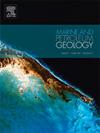北红海沙班深构造背景与多期火山作用
IF 3.7
2区 地球科学
Q1 GEOSCIENCES, MULTIDISCIPLINARY
引用次数: 0
摘要
沙班深(ShD)是在红海北部发现的几个轴向凹陷之一,一些被认为是海底扩张的早期地点。了解ShD的演化历史和盐构造对控制裂谷-漂变具有重要意义。该研究综合了二维地震反射剖面、重力、磁和水深数据,研究了ShD的区域构造框架、盐构造和火山作用。地震资料清晰地反映了蒸发后(上第四纪)地层,而火成岩基底内的反射则是可变的。断层至少部分是由逐渐变陡的反射面推断出来的,这表明生长地层学。在北西-东南向的细长新火山轴脊周围,确定了北西-东南向和北东-西南向两个主要的伸展断裂系统。主要的NE-SW断裂垂直于红海裂谷轴,形成若干基底控制的弧形半地堑。ShD的结构框架各不相同。在东南地区,主要的NE-SW伸展断裂向NW倾斜,在晚中新世至第四纪期间经历了多次活化阶段。而西北缘的主断裂可能是在上第四纪沉积后发育的,倾角更陡。尽管缺乏强有力的证据证明ShD附近存在盐底喷井(可能是由于火山火山口的形成),但在最东端地区,明显的海底弯曲和变形的蒸发岩表明盐的运动可能在晚中新世开始。地震解释和地球化学研究表明,轴向火山脊是由多期火山作用形成的,化学成分不均匀的玄武岩熔岩证明了这一点。这个山脊周围是一个5.7 × 8.5公里的火山口。本文章由计算机程序翻译,如有差异,请以英文原文为准。
Structural setting and multiphase volcanism in the Shaban Deep, Northern Red Sea
Shaban Deep (ShD) is one of several axial depressions discovered in the northern Red Sea, some considered sites of incipient seafloor spreading. Understanding the evolutionary history and salt tectonics of ShD is essential for constraining the rift-to-drift transition. This study integrates 2D seismic reflection profiles, gravity, magnetic, and bathymetric data to investigate the regional structural framework, salt tectonics, and volcanism in ShD. The seismic data clearly image the post-evaporite (Plio-Quaternary) strata, while reflections within the igneous basement are variable. Faults are at least partly inferred from progressively steepening reflectors, indicative of growth stratigraphy. Two main extensional fault systems, trending NW-SE and NE-SW, have been identified around an elongate NW-SE neo-volcanic axial ridge. The dominant NE-SW faults, perpendicular to the Red Sea rift axis, form several basement-controlled arcuate half-grabens. The structural framework varies across ShD. In the southeastern region, major NE-SW extensional faults dip to the NW and are interpreted as listric faults that experienced several reactivation phases between the Late Miocene and Quaternary. In contrast, the primary faults in the northwestern ShD likely developed after the deposition of Plio-Quaternary sediments and exhibit steeper dip angles. Despite the lack of strong evidence for the presence of salt diapirs near ShD, likely due to the formation of a volcanic caldera, significant seafloor bending and deformed evaporites on the easternmost area suggest salt movement, which likely began during the Late Miocene. Seismic interpretation, supported by previous geochemical studies, indicates that the axial volcanic ridge formed through multiphase volcanism, as evidenced by chemically heterogeneous basaltic lavas. This ridge is surrounded by a caldera measuring 5.7 × 8.5 km.
求助全文
通过发布文献求助,成功后即可免费获取论文全文。
去求助
来源期刊

Marine and Petroleum Geology
地学-地球科学综合
CiteScore
8.80
自引率
14.30%
发文量
475
审稿时长
63 days
期刊介绍:
Marine and Petroleum Geology is the pre-eminent international forum for the exchange of multidisciplinary concepts, interpretations and techniques for all concerned with marine and petroleum geology in industry, government and academia. Rapid bimonthly publication allows early communications of papers or short communications to the geoscience community.
Marine and Petroleum Geology is essential reading for geologists, geophysicists and explorationists in industry, government and academia working in the following areas: marine geology; basin analysis and evaluation; organic geochemistry; reserve/resource estimation; seismic stratigraphy; thermal models of basic evolution; sedimentary geology; continental margins; geophysical interpretation; structural geology/tectonics; formation evaluation techniques; well logging.
 求助内容:
求助内容: 应助结果提醒方式:
应助结果提醒方式:


